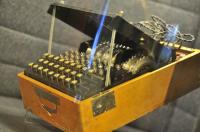How are the WUT and the deciphering of the 'Enigma' connected?

phot. Pilsudski Institute London, Wikipedia, CC-BY-SA 4.0
To solve this puzzle, we have to go back to the turbulent years when Poland was getting back its independence. Antoni Palluth – the son of a postal worker from Pobiedziska was 18 years old in 1918. During his service in the Polish Army's Communications division, when he was manning a radio station in the Poznań Fortress (also known as the Citadel), among his other tasks, he met Maksymilian Ciężki, just two years his senior. This is where it all began.
Meeting Ciężki sparked Palluth's interest in short-wave radio and cryptology. It soon became apparent that his future would be linked to this. However, in the early 1920s, he got involved with the Warsaw University of Technology. Between 1921-1925 he was a student and in 1927-1929 an unenrolled student at the Faculty of Civil Engineering.
Entrepreneur and teacher
In the middle of the 1930s, Palluth began working in the Cipher Bureau of the Main Staff of the Polish Armed Forces, in the German ciphers section. He was the ideal candidate: not only did he possess knowledge of cryptology and experience in radiocommunications, but he was also fluent in German (including dialects).
In 1928, together with Stanisław Danilewicz, Ludomir Danilewicz and Edward Fokczyński, he founded the 'AVA' Radio-technical Production Plant (Wytwórnia Radiotechniczna 'AVA'). It produced radio equipment and in the next few years played an important role in solving the German Enigma machine cipher.
Another breakthrough in the life of this Warsaw University of Technology engineer came in 1929. That's when Palluth became a lecturer at secret military cryptology courses in Poznań. These were attended by, among others, young graduates of the Poznań University's mathematics faculty: Marian Rejewski, Henryk Zygalski and Jerzy Różycki. Nowadays, we know them as those who cracked the Enigma cipher.
Deciphering it posed a great challenge. After all, the Germans considered the 'Enigma' to be a miracle of technology. Finally, at the end of 1932, Polish cryptologists cracked the cypher.
But this was not the end of their work. In 1933 or 1934 (both dates appear in sources), the first Polish replicas of the machine were made. Of course, they were produced at the 'AVA' plant, owned by Palluth, among others. The copies allowed specialists to reproduce German ciphers much quicker than before. As stated on the website of the Virtual Museum of Pobiedziska: It was a great success for the constructors, mathematicians and cryptologists, and a lot of credit must be given to Eng. Antoni Palluth, who worked as the main co-ordinator and creator of the reconstructed German 'Enigma'.
Help for allies
The constructors from the 'AVA' plant created also a cyclometer (a cipher cracking accelerator) and a device for recovering 'Enigma' keys (the so-called cryptographic bomb) to automate decryption work. Under Palluth's direction the 'Lacida', the original Polish encryption machine, was created.
In 1939, replicas of the 'Enigma' built in the 'AVA' facility were transferred to military staff in Great Britain and France. This allowed them to read secret German messages transmitted by radio throughout World War II.
Successes and tragedies
What happened to Antoni Palluth during the war? Together with a group from the Cipher Bureau he fled Poland, first to Romania and then to southern France. There he became the technical manager of a secret anti-German intelligence centre. His greatest success in over two years of work was the breaking of another German cipher. This one was used by agents operating in French Mediterranean ports, who were in constant contact with the intelligence headquarters in Stuttgart.
When the Germans occupied the south of France in November 1942, a group of Polish cryptologists tried to evacuate to Spain and then to Great Britain. Palluth didn't succeed. He was sent to the Sachsenhausen – Oranienburg concentration camp. He was killed on 18 April 1944 during Allied bombings.
Who broke the 'Enigma' cipher remained a mystery long after the end of World War II.
The participants became known only in the 1970s. Historians estimate that solving the cipher shortened the war by about 3 years.
Agnieszka Kapela
Office of Promotion and Information
___________
On the basis of:
Antoni Palluth [in:] collection of Wirtualne Muzeum Pobiedzisk (Pobiedziska Virtual Museum), http://muzeum.pobiedziska.pl/eksponat/eks_pdf/id/484, retrieved: 27 July 2017.
Antoni Palluth [in:] Internetowy Polski Słownik Biograficzny (Online Polish Biographical Dictionary), http://www.ipsb.nina.gov.pl/a/biografia/antoni-palluth, retrieved: 27 July 2017.
Złamali szyfr „Enigmy”, ocalili 30 milionów ludzi (They broke the 'Enigma' cipher, saving 30 million people), http://www.polskieradio.pl/39/156/Artykul/752845,Zlamali-szyfr-Enigmy-ocalili-30-milionow-ludzi, retrieved: 27 July 2017.







